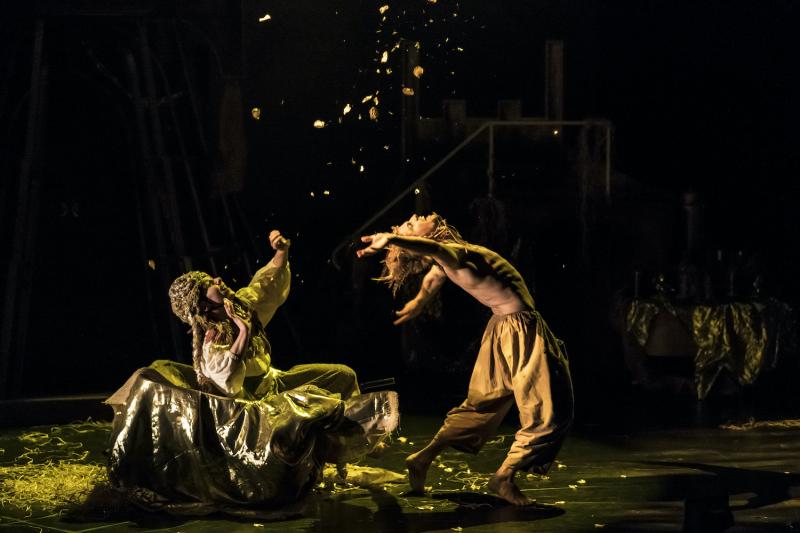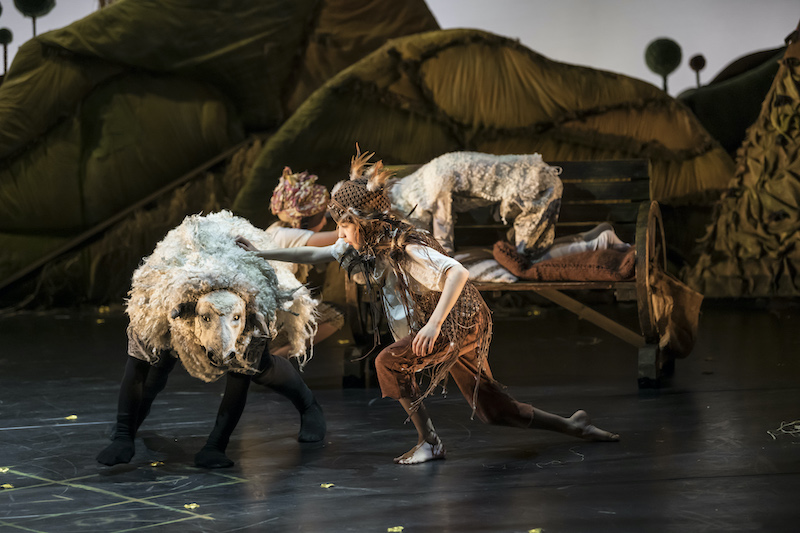Rumpelstiltskin, Sadler's Wells Digital Stage review - spins an engaging yarn for young audiences | reviews, news & interviews
Rumpelstiltskin, Sadler's Wells Digital Stage review - spins an engaging yarn for young audiences
Rumpelstiltskin, Sadler's Wells Digital Stage review - spins an engaging yarn for young audiences
balletLORENT provides a sunnier take on the the Brothers Grimm

The latest in Sadler’s Wells’ Digital Stage programme – an impressively assembled online offering to keep audiences entertained during the shutdown – is balletLORENT’s family-friendly dance-theatre production Rumpelstiltskin. It was streamed as a "matinee" on Friday afternoon, and is avail
The 90-minute work, first seen in 2018 and filmed for broadcast at Northern Stage, was the third successful collaboration between director Liv Lorent and then poet laureate Carol Ann Duffy – once again translating a Brothers Grimm tale for the stage. BalletLORENT were meant to be bringing their latest show, The Lost Happy Endings, to Sadler’s Wells for its Family Weekend this Easter; instead, Rumpelstiltskin plays online, offering entertainment to both restless young viewers and their grateful parents.
While not quite as, well, grim as the original tale, this retelling of the iconic fable still has a certain darkness underlying its bucolic setting. We open with the title character’s origin story: the Queen (Maria Vincentelli) longs for a child, but dies giving birth. The grief-stricken King (John Kendall) then casts out his son – who becomes Rumpelstiltskin (Gavin Coward), unloved and increasingly feral, but with a certain talent for magical weaving. Years later, a Shepherd (Toby Fitzgibbons) fatally boasts that his daughter (Natalie Trewinnard, pictured below) can spin straw into gold. The King locks her in a room with a spinning wheel, proclaiming he will slaughter her father’s flock if she fails, or marry her if she succeeds. She’s saved by Rumpelstiltskin, but his help comes at a terrible price.
 Giving Rumpelstiltskin a painful childhood tilts our sympathies; is he really the ‘villain’ here, or is it his father – or neither? The story becomes more explicitly about parenting, community, loss, and how we all need love and understanding to thrive. The arresting opening image of the queen writhing in her liquid-gold cloak connects that vivid thread to her, so gold here is not a sign of the King hoarding riches, but once again opening his heart. We see, too, the Queen’s spirit haunting Rumpelstiltskin, making his talent part of that traumatic inheritance.
Giving Rumpelstiltskin a painful childhood tilts our sympathies; is he really the ‘villain’ here, or is it his father – or neither? The story becomes more explicitly about parenting, community, loss, and how we all need love and understanding to thrive. The arresting opening image of the queen writhing in her liquid-gold cloak connects that vivid thread to her, so gold here is not a sign of the King hoarding riches, but once again opening his heart. We see, too, the Queen’s spirit haunting Rumpelstiltskin, making his talent part of that traumatic inheritance.
More could be done with the magical elements, which are rather understated; it’s a shame Lorent doesn’t have more fun exploring this superpower, something young audiences would surely enjoy. Also, by giving the Shepherd’s Daughter a romantic bond with Rumpelstiltskin, the show creates a weird semi-incestuous love triangle (and paternity mystery) that might have kids asking awkward questions. Is Dr Freud available for home schooling? Or Jeremy Kyle?
Ben Crompton’s warm narration guides the action, and Lorent’s contemporary choreography is brimming with character notes. Fitzgibbons’ overreaching Shepherd has a wild buoyancy, breaking into tap dancing when particularly excited. The King and Queen’s affection is immediately established by their tactile, entwined partnering, while the Queen’s longing for parenthood is evident in her sprightly playing with the village children, the luminous Vincentelli almost childlike herself in her unfettered movement.
Contrasting with that joyful spirit is Kendall’s aggressive, jagged movement as the King is warped by grief – movement which then shapes his child, with Coward supplying gawky, animalistic physicality that shows Rumpelstiltskin’s increasing separation from humanity. He has feathers sticking comically out of his hat, making him an object of fun, but also of pity. The expressive Trewinnard is most compelling when the Shepherd’s Daughter despairs at her task: tearing and hurling straw, running in place on the spinning wheel, and even standing on her head. Her relationship with Rumpelstiltskin is interestingly drawn: part loyalty, part calculation, part desire, as childhood friends shift into complex adolescence.
 Supporting them are company members and a community cast aged four to 79, who play country folk and the instantly adorable gambolling sheep (pictured above). But, apart from a set-piece in which everyone tries to cheer the King (with tricks ranging from hula hooping and rhythmic gymnastics to a shepherd-sheep pas de deux and cheerleading with straw bundles), there isn’t really space for Lorent to let loose choreographically. Though admirable as clear narrative, the dancing, like this version of the tale, is too earthbound, lacking transporting magic.
Supporting them are company members and a community cast aged four to 79, who play country folk and the instantly adorable gambolling sheep (pictured above). But, apart from a set-piece in which everyone tries to cheer the King (with tricks ranging from hula hooping and rhythmic gymnastics to a shepherd-sheep pas de deux and cheerleading with straw bundles), there isn’t really space for Lorent to let loose choreographically. Though admirable as clear narrative, the dancing, like this version of the tale, is too earthbound, lacking transporting magic.
Nevertheless, it’s a delightful world to enter. Phil Eddolls’ russet and emerald set features a fairy tale castle and plump hillocks that resemble comfy sofas, while Games of Thrones’ Michele Clapton immerses the folk in wool via hippy-meets-medieval costuming, giving the Shepherd’s Daughter knitted plaits. Malcolm Rippeth and Michael Morgan’s lighting switches between sunny idyll and ominous dark, accentuating the Shepherd’s Daughter and her nemesis, the spinning wheel, with giant shadows on the back wall. Likewise, Doctor Who composer Murray Gold provides both cheery folk music and mythic power, and, other than some sluggish pacing, the production translates well to screen – its jaunty visuals, swelling score and emphasis on characterisation all engaging for wide-ranging audiences.
Completing this accessible family offering is an online workshop series from Sadler’s Wells, with activities like balancing, jumping and rhythm. It’s a lovely way to find a positive in the shutdown: reaching new audiences, and converting their enthusiasm for watching dance into doing it themselves. The programming equivalent of spinning gold from straw.
- Rumpelstiltskin on Sadler’s Wells’ Facebook and YouTube until 10 April
- More dance reviews on theartsdesk
rating
Explore topics
Share this article
The future of Arts Journalism
You can stop theartsdesk.com closing!
We urgently need financing to survive. Our fundraising drive has thus far raised £49,000 but we need to reach £100,000 or we will be forced to close. Please contribute here: https://gofund.me/c3f6033d
And if you can forward this information to anyone who might assist, we’d be grateful.

Subscribe to theartsdesk.com
Thank you for continuing to read our work on theartsdesk.com. For unlimited access to every article in its entirety, including our archive of more than 15,000 pieces, we're asking for £5 per month or £40 per year. We feel it's a very good deal, and hope you do too.
To take a subscription now simply click here.
And if you're looking for that extra gift for a friend or family member, why not treat them to a theartsdesk.com gift subscription?
more Dance
 'We are bowled over!' Thank you for your messages of love and support
Much-appreciated words of commendation from readers and the cultural community
'We are bowled over!' Thank you for your messages of love and support
Much-appreciated words of commendation from readers and the cultural community
 R:Evolution, English National Ballet, Sadler's Wells review - a vibrant survey of ballet in four acts
ENB set the bar high with this mixed bill, but they meet its challenges thrillingly
R:Evolution, English National Ballet, Sadler's Wells review - a vibrant survey of ballet in four acts
ENB set the bar high with this mixed bill, but they meet its challenges thrillingly
 Like Water for Chocolate, Royal Ballet review - splendid dancing and sets, but there's too much plot
Christopher Wheeldon's version looks great but is too muddling to connect with fully
Like Water for Chocolate, Royal Ballet review - splendid dancing and sets, but there's too much plot
Christopher Wheeldon's version looks great but is too muddling to connect with fully
 iD-Reloaded, Cirque Éloize, Marlowe Theatre, Canterbury review - attitude, energy and invention
A riotous blend of urban dance music, hip hop and contemporary circus
iD-Reloaded, Cirque Éloize, Marlowe Theatre, Canterbury review - attitude, energy and invention
A riotous blend of urban dance music, hip hop and contemporary circus
 How to be a Dancer in 72,000 Easy Lessons, Teaċ Daṁsa review - a riveting account of a life in dance
Michael Keegan-Dolan's unique hybrid of physical theatre and comic monologue
How to be a Dancer in 72,000 Easy Lessons, Teaċ Daṁsa review - a riveting account of a life in dance
Michael Keegan-Dolan's unique hybrid of physical theatre and comic monologue
 A Single Man, Linbury Theatre review - an anatomy of melancholy, with breaks in the clouds
Ed Watson and Jonathan Goddard are extraordinary in Jonathan Watkins' dance theatre adaptation of Isherwood's novel
A Single Man, Linbury Theatre review - an anatomy of melancholy, with breaks in the clouds
Ed Watson and Jonathan Goddard are extraordinary in Jonathan Watkins' dance theatre adaptation of Isherwood's novel
 Peaky Blinders: The Redemption of Thomas Shelby, Rambert, Sadler's Wells review - exciting dancing, if you can see it
Six TV series reduced to 100 minutes' dance time doesn't quite compute
Peaky Blinders: The Redemption of Thomas Shelby, Rambert, Sadler's Wells review - exciting dancing, if you can see it
Six TV series reduced to 100 minutes' dance time doesn't quite compute
 Giselle, National Ballet of Japan review - return of a classic, refreshed and impeccably danced
First visit by Miyako Yoshida's company leaves you wanting more
Giselle, National Ballet of Japan review - return of a classic, refreshed and impeccably danced
First visit by Miyako Yoshida's company leaves you wanting more
 Quadrophenia, Sadler's Wells review - missed opportunity to give new stage life to a Who classic
The brilliant cast need a tighter score and a stronger narrative
Quadrophenia, Sadler's Wells review - missed opportunity to give new stage life to a Who classic
The brilliant cast need a tighter score and a stronger narrative
 The Midnight Bell, Sadler's Wells review - a first reprise for one of Matthew Bourne's most compelling shows to date
The after-hours lives of the sad and lonely are drawn with compassion, originality and skill
The Midnight Bell, Sadler's Wells review - a first reprise for one of Matthew Bourne's most compelling shows to date
The after-hours lives of the sad and lonely are drawn with compassion, originality and skill
 Ballet to Broadway: Wheeldon Works, Royal Ballet review - the impressive range and reach of Christopher Wheeldon's craft
The title says it: as dancemaker, as creative magnet, the man clearly works his socks off
Ballet to Broadway: Wheeldon Works, Royal Ballet review - the impressive range and reach of Christopher Wheeldon's craft
The title says it: as dancemaker, as creative magnet, the man clearly works his socks off
 The Forsythe Programme, English National Ballet review - brains, beauty and bravura
Once again the veteran choreographer and maverick William Forsythe raises ENB's game
The Forsythe Programme, English National Ballet review - brains, beauty and bravura
Once again the veteran choreographer and maverick William Forsythe raises ENB's game

Add comment